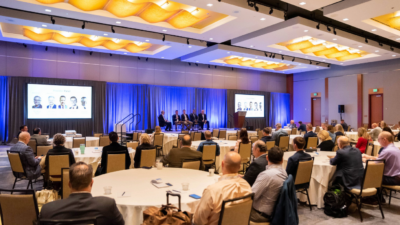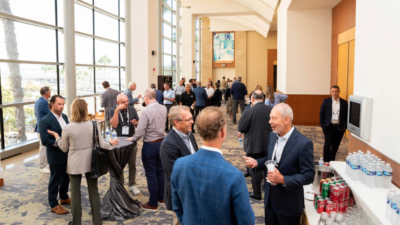Commercial real estate in Philadelphia is significantly tied to the future of its institutions of higher education and healthcare. In 2016, Educational and Health Services Employers (Eds and Meds) employed 30% of the workforce in the Philadelphia Metropolitan Area as reported by the U.S. Bureau of Labor Statistics.
Two of the region’s leading visionaries in healthcare and higher education discussed the exciting, transformational possibilities for the future of these consumer-centric industries. Steve Klasko, President & CEO of Thomas Jefferson University & Jefferson Health and John Fry, President of Drexel University.
What will the hospital campus and medical office building/campus look like over the next 10 years?
Steve Klasko: Ten years from now everything will be much more virtual. Our product is our care and caring. We will need 25% less hospitals. There will be smaller buildings equipped with artificial intelligence and deep learning to handle seriously ill patients. Hip replacements, knee replacements are going to outpatient services. At Jefferson, we have two legacy inpatient facilities. Ten years from now, they might be clinical research labs and simulation centers.
What happens when we need 25% less beds? If you look at the six academic medical centers in Philadelphia, the chance that all six of them will be independent entities in 10 years is about zero. There might be four health systems in Pennsylvania. You have to do so much more for so much less; you can’t be an independent entity without becoming part of something bigger. We’ve gone from a $1.2B entity to a $5B entity with the integration we’re doing, so we can survive and prosper.
What do you see as the key disruptor(s) in the healthcare sector and how will this transform Jefferson Health over the next 10 years?
SK: The key disrupter will be that we’ll finally be forced to join the consumer revolution. We must make healthcare a right and not a privilege and we have to control costs. Healthcare is going to have to be consumer-centric.
The second disrupter is the whole government healthcare issue. The simple fact is we have $1 to pay for $1.25 worth of stuff. Once you realize that, everything changes, which is what happened in retail. You start to get rid of distributors and anything that puts stress on that dollar to become more efficient. At Jefferson, we’ve invested $25M in Telehealth and have the largest Telehealth network in the country.
Another major disrupter is artificial intelligence. Within four years, deep learning and robots will be better than I am at memorizing things. We’ll start selecting doctors with more human characteristics like empathy, self-awareness, communication skills and cultural competence. We’re already starting that at Jefferson. We’ve started teaching skills like empathy and we’ve started simulation centers that concentrate on how people communicate.
How will technology, electronic medical records, online medicine and other innovations impact the delivery of and real estate for health care?
SK: You’ll see much less in-patient care. You’ll see much more retail. There will be more opportunities for real estate to combine with retail. The mall of the future will have significant healthcare genomics. You could buy your Lucky Brand jeans and then go next door and get your genes checked at Jefferson —those kinds of synergies.
There will be more micro hospitals —small facilities with 10 beds and an urgent care center —so people can actually be admitted if they need to stay for 24 hours. We must get rid of the ridiculously arcane view that anything less than 24 hours is outpatient and anything more is inpatient.
Your house will be totally health-connected. Electronic medical records (EMRs) will be connected to wearables. Your undergarments will be able to determine if you have an irregular heartbeat and that information will get communicated to your doctor. It will be a completely connected system. In my specialty of obstetrics, there won’t be stillbirths anymore because I’ll be able to know the baby’s heartbeat literally on an ongoing basis.
We’ll start to see medicine follow what’s already happening in high-reliability organizations like power plants or manufacturing where there is much less human error and much more deep learning. The patient will always be monitored wherever they are, not just in the doctor’s office or the hospital.
How are you leveraging the merger with Philadelphia University to integrate design into the delivery of healthcare?
SK: We merged with Philadelphia University because the whole next revolution is going to be around design and the human experience in a healthcare environment. We spend a lot of time thinking about the integration of design and healthcare. Jefferson is looking at new partnerships between hospitals and companies to design their workplace, to design their food and look at everything that their employees do.
How much will the traditional medical school curriculum change?
SK: The whole curricula will change and is changing already. Everything in healthcare is episodic. We’re working to develop a continuum. It’s lifestyle medicine. We’ve started the Institute for Emerging Health Professionals to identify and train for the jobs that are going to be needed 10 years from now. That includes community ambassadors, masters in aging in place, masters in cannabis medical education and research and, with Philadelphia University, we are developing programs in healthcare hospitality and healthcare architecture. Even the jobs are going to become less episodic and more continuum.
We interviewed doctors across the country who’d been out of school three years or less and they basically said, I have $450,000 worth of debt and you’ve taught me half of what I need to know. You taught me biochemistry and microbiology and I don’t use much of that in my day to day. You didn’t teach me how to communicate, how to manage pain, how to be an individual in an organization, what happens at home, how to be a leader. We need more than just a little peppering … we need a disruption.
Will the private sector become more involved in partnerships with Jefferson and other academic medical centers/health systems in Philadelphia and the Northeast?
SK: You’ll start to see partnerships between medical schools, nursing schools and the private sector. We’re talking to a couple of companies—IBM Watson and Google—built around the premise that they’re going to have a deep learning robot next year. How does that change how you teach? It’s no different than having to change medical schools when antibiotics came out. It will be that big a deal.
How we work with the private sector is also going to get transformed. We announced on July 17 the largest provider service agreement with General Electric in their history … $1B over eight years. They are our partner in integration, not a consultant. What’s changed is they’re there for eight years; they’re embedding 30-50 people in our space so, if you came into our senior management suite, you wouldn’t be able to tell who was employed by GE and who was employed by Jefferson and their incentives are the same as my incentives. So, if I don’t get an incentive, they don’t get paid. And the incentives all revolve around quality, access and cost.
There will be much more innovative private sector/healthcare entity partnerships. Some of the big residential real estate firms will be looking to partner with Jefferson so that every one of their houses will be a healthy house.
I’ll leave you with this. We’re going through this once-in-a-lifetime transformation in healthcare from a business-to-business model to a business-to-consumer model. This is not unlike what happened in the 2000s when Steve Jobs came up with the iPod and everybody laughed. He recognized what was occurring was a once in a lifetime transformation from computer companies to a digital lifestyle.
What do you see as the key disruptor(s) to higher education over the next 10 years?
John Fry: Number one is how to give students the gift of this type of education and make it affordable. Even if a particular college or university is attractive to a student, if it’s not accessible and affordable, they’re not going to be able to attend. It’s a very fundamental thing. Drexel has rolled back the level of increase in our tuition, room and board and fees to under 2% in recent years and has put more financial investment into our financial aid packaging and budgets.
Number two is all the additional technology that will be available for teaching. Just as online seemed exotic to us 20 years ago and is now ubiquitous, so too will all sorts of modes of augmented reality and artificial intelligence that are going to find their way into the class room. We need to keep pace with students’ needs in terms of content being delivered to them in the most contemporary ways, and we will need to be facile with this and ready to experiment.
How will we be educating our students 10 years from now?
JF: The way we’re going to educate students 10 years from now and beyond is in a combined way. There will be face to face, but I expect more hybrid and online, and honestly, I expect students—as our customers—are going to want all three and they’re going to want them in an easily accessible way. I’m seeing this right now on our campus. Obviously, we do a huge amount of face-to-face education but within the context of that, we’re doing a lot of hybrid.
We have so many students on cooperative education—which means they’re away from campus working full time—and they take classes online to keep up with what they’re doing. I’ve noticed that while we as older people make a distinction among those three things, students move seamlessly from a seminar to a big online course to a medium-size hybrid course. They’re just expecting to be able to move quickly and efficiently from one to the other.
How will this impact the built environment of college campuses and the cities that surround them?
JF: We are still going to need academic and residential buildings, but the emphasis is going to be on mixing campus life with city life so there is a more seamless connection between them. Sort of town with gown. Urban campuses are going to continue to be the hottest campuses with the most demand by students simply because students crave the diversity of urban campuses in terms of the people they attract, the neighborhoods they are in and the access to other parts of great cities they give.
From a real estate standpoint, I see more campus development but done more seamlessly within the context of neighborhoods. Classrooms will be completely smart and can host hybrid and online as easily as they can host people sitting in rooms together learning from one another. The big calculation institutions are going to have to make is where they want to put their capital. We’re going to see a lot more capital flowing into online infrastructure—maybe at the expense of the brick and mortar campuses—but that’s yet to be seen. I expect there will continue to be a relationship between one and the other.
What does collaboration with private development partners hold in store for the future?
JF: It’s huge. Residences, dining, commercial amenities, hotels for visitors, maybe even athletic facilities don’t need to be created or owned and operated by a university if you have good partners. We’ve been very lucky to have great partners like American Campus Communities and Hospitality 3, and Brandywine Realty Trust. That’s why we created Schuylkill Yards in the first place. When you think about things we’d like to have on our campus, but don’t necessarily need to own, being adjacent to a major commercial district creates incredible opportunities for our students and our faculty in terms of collaboration, co-ops and research partnerships.
Some institutions are still wary about partnering with commercial developers; they think it means giving up control. I would urge them to conserve their capital and look for the kind of expertise that exists in the commercial marketplace. It’s increasingly what institutions must think about, particularly since the campus of the future is going to look very different from the way in which they built campuses in the past.
How will technology and student preferences impact education over the next 10 years?
JF: There’s a great deal of experimentation and piloting going on now with artificial intelligence. Learning is going to continue to evolve. As children grow up in technology-ubiquitous environments, future students will find all sorts of ways in which to learn. We need to be with them, if not slightly ahead of them.
By being involved in all those technological modalities, testing them, piloting them, learning about them, figuring out whether they suit us—especially from a business model standpoint, and then as the future reveals itself—hopefully, we’ll have enough irons in the fire to cope with what the new educational models are going to look like.
We started an online subsidiary 15 years ago and it is the most dynamic part of what we do. It’s constantly evolving to ensure the customer experience is a great one. Not just the way in which we teach online but also when we’re trying to recruit and attract students. Gone are the days when a student submits an application and waits three months. They’re going to expect a complete turnaround, including financial aid, within 72 hours, if not 48 hours. It’s not only on the learning side, it’s also in the way we manage the customer experience, and time is money. If you can’t get back to people quickly with an answer to their questions, they’re just going to move on to the next possibility.
What will we see more/less of?
JF: Interestingly enough, I think libraries will become even more relevant than they are, where people interact in open learning environments. Many people predicted that online courses would lead to the demise of libraries. Our library is more full than it has ever been. We’re very excited about the future of libraries here.
Over time, I expect to see less of the large 200-person lecture hall. We might see a breakdown in the scale of those types of courses in person, perhaps replaced by online lectures and opportunities in a hybrid setting under the direction of faculty with smaller groups of 10 or 15, not 150 or 200.
What’s important is to have a capital budget planning and allocation process that is always looking at brick and mortar but also has a very robust technological component to it for classrooms and online learning. You’re going to see more of those conversations going forward, whereas they used to be handled in separate conversations.
Given the recent extreme weather events, do you feel climate change will impact how you plan for the future?
JF: Hardly any place is immune from these kinds of natural disasters at this point. We saw it very close to home in 2012 (super-storm Sandy). Now, we’re seeing tragedies unfold in Texas, Florida, Puerto Rico and Northern California, and institutions have to get ready for this. I expect we are all going to be thinking about zero-energy impact buildings, buildings that can withstand extreme weather, buildings that are environmentally sustainable, buildings that our students are going to demand increasingly because of the ethos of this generation. I think it will be a key factor going forward.

 Colliers Insights Team
Colliers Insights Team
 Katie Sobotowski
Katie Sobotowski
 Shawn Janus
Shawn Janus Kevin Rude
Kevin Rude
 Jacob Mumper
Jacob Mumper